Curriculum Development of Health Education Professionals: PPE Focus
VerifiedAdded on 2021/04/21
|14
|2768
|104
Report
AI Summary
This report outlines a curriculum development plan for health education professionals, specifically targeting trainee healthcare workers, with the aim of improving their knowledge and skills in using Personal Protective Equipment (PPE) for infection control. The assignment utilizes the ADDIE model (Analysis, Design, Development, Implementation, and Evaluation) to create an effective learning solution. The analysis phase identifies the problem of Healthcare-Acquired Infections (HCAIs) caused by competency gaps among healthcare workers and defines the target audience and required resources. The design and development phases outline learning outcomes across cognitive, affective, and psychomotor domains, along with teaching strategies like workshops and audio-visual aids. The implementation phase details the 60-minute educational event, including lecture, demonstration, and Q&A sessions. The evaluation phase incorporates formative assessments through group discussions and summative evaluations at three levels: perception (surveys), learning (oral tests and demonstrations), and performance (workplace observation). The curriculum emphasizes the importance of PPE in preventing HCAIs and aims to enhance the trainees' ability to implement infection control practices effectively.
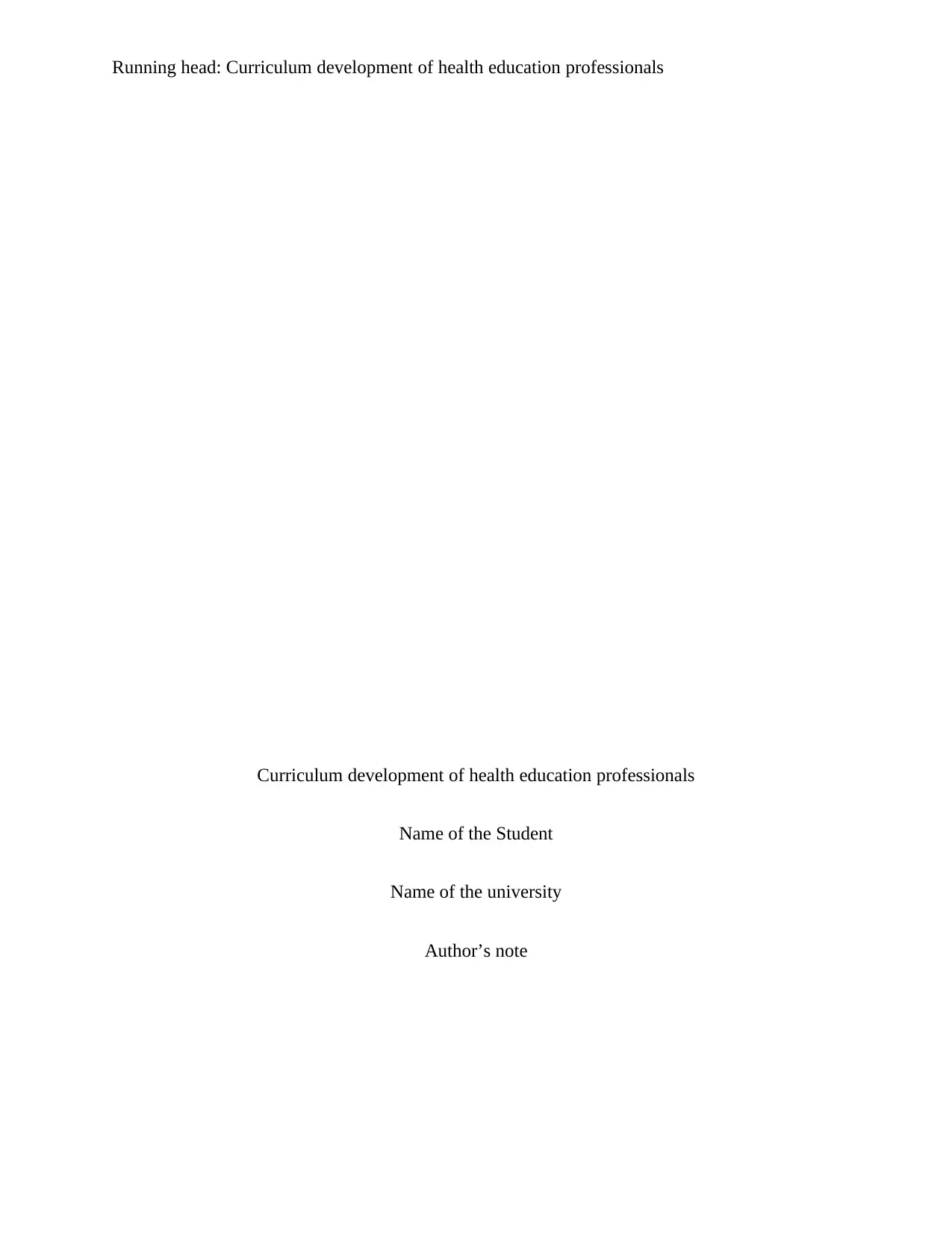
Running head: Curriculum development of health education professionals
Curriculum development of health education professionals
Name of the Student
Name of the university
Author’s note
Curriculum development of health education professionals
Name of the Student
Name of the university
Author’s note
Paraphrase This Document
Need a fresh take? Get an instant paraphrase of this document with our AI Paraphraser
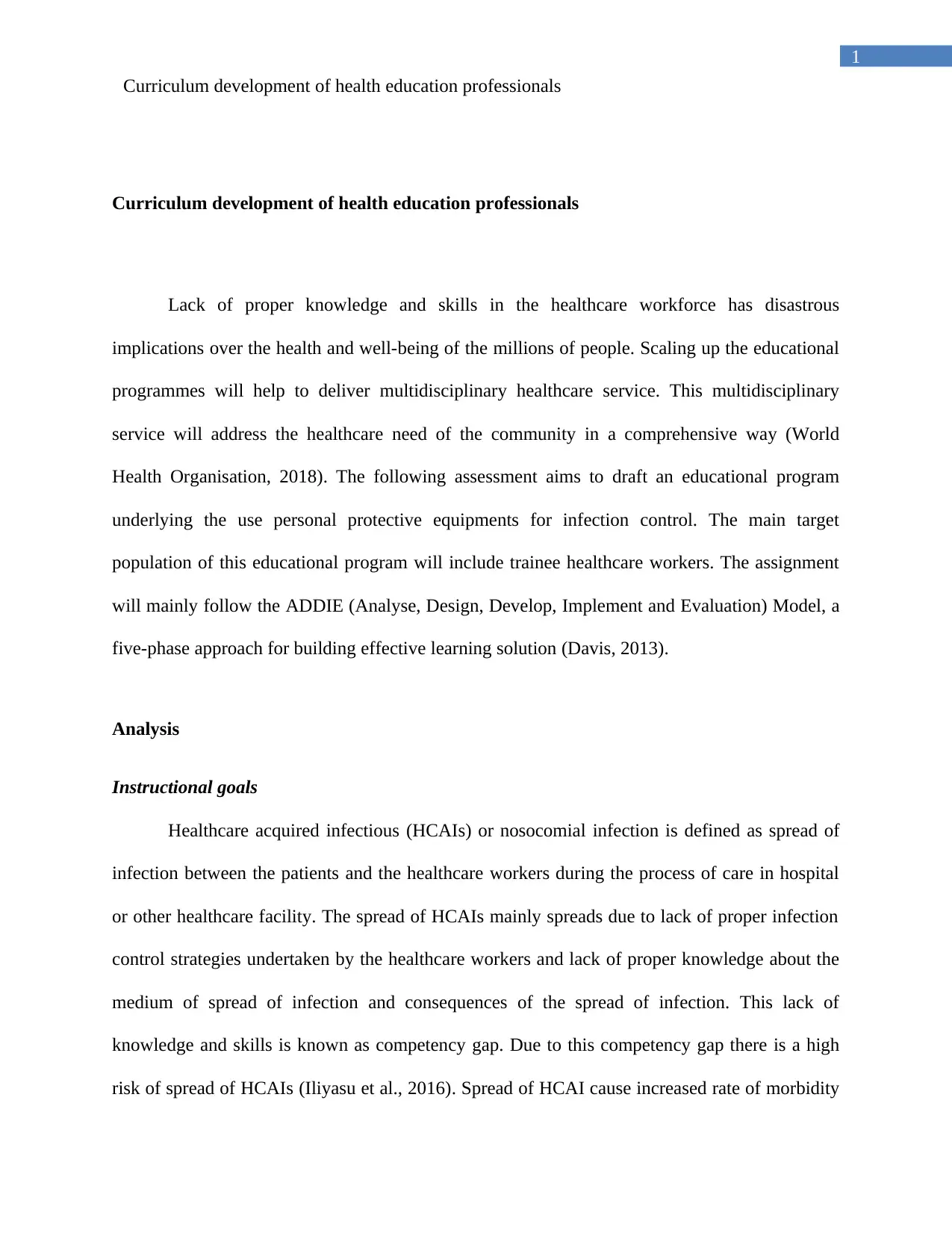
1
Curriculum development of health education professionals
Curriculum development of health education professionals
Lack of proper knowledge and skills in the healthcare workforce has disastrous
implications over the health and well-being of the millions of people. Scaling up the educational
programmes will help to deliver multidisciplinary healthcare service. This multidisciplinary
service will address the healthcare need of the community in a comprehensive way (World
Health Organisation, 2018). The following assessment aims to draft an educational program
underlying the use personal protective equipments for infection control. The main target
population of this educational program will include trainee healthcare workers. The assignment
will mainly follow the ADDIE (Analyse, Design, Develop, Implement and Evaluation) Model, a
five-phase approach for building effective learning solution (Davis, 2013).
Analysis
Instructional goals
Healthcare acquired infectious (HCAIs) or nosocomial infection is defined as spread of
infection between the patients and the healthcare workers during the process of care in hospital
or other healthcare facility. The spread of HCAIs mainly spreads due to lack of proper infection
control strategies undertaken by the healthcare workers and lack of proper knowledge about the
medium of spread of infection and consequences of the spread of infection. This lack of
knowledge and skills is known as competency gap. Due to this competency gap there is a high
risk of spread of HCAIs (Iliyasu et al., 2016). Spread of HCAI cause increased rate of morbidity
Curriculum development of health education professionals
Curriculum development of health education professionals
Lack of proper knowledge and skills in the healthcare workforce has disastrous
implications over the health and well-being of the millions of people. Scaling up the educational
programmes will help to deliver multidisciplinary healthcare service. This multidisciplinary
service will address the healthcare need of the community in a comprehensive way (World
Health Organisation, 2018). The following assessment aims to draft an educational program
underlying the use personal protective equipments for infection control. The main target
population of this educational program will include trainee healthcare workers. The assignment
will mainly follow the ADDIE (Analyse, Design, Develop, Implement and Evaluation) Model, a
five-phase approach for building effective learning solution (Davis, 2013).
Analysis
Instructional goals
Healthcare acquired infectious (HCAIs) or nosocomial infection is defined as spread of
infection between the patients and the healthcare workers during the process of care in hospital
or other healthcare facility. The spread of HCAIs mainly spreads due to lack of proper infection
control strategies undertaken by the healthcare workers and lack of proper knowledge about the
medium of spread of infection and consequences of the spread of infection. This lack of
knowledge and skills is known as competency gap. Due to this competency gap there is a high
risk of spread of HCAIs (Iliyasu et al., 2016). Spread of HCAI cause increased rate of morbidity
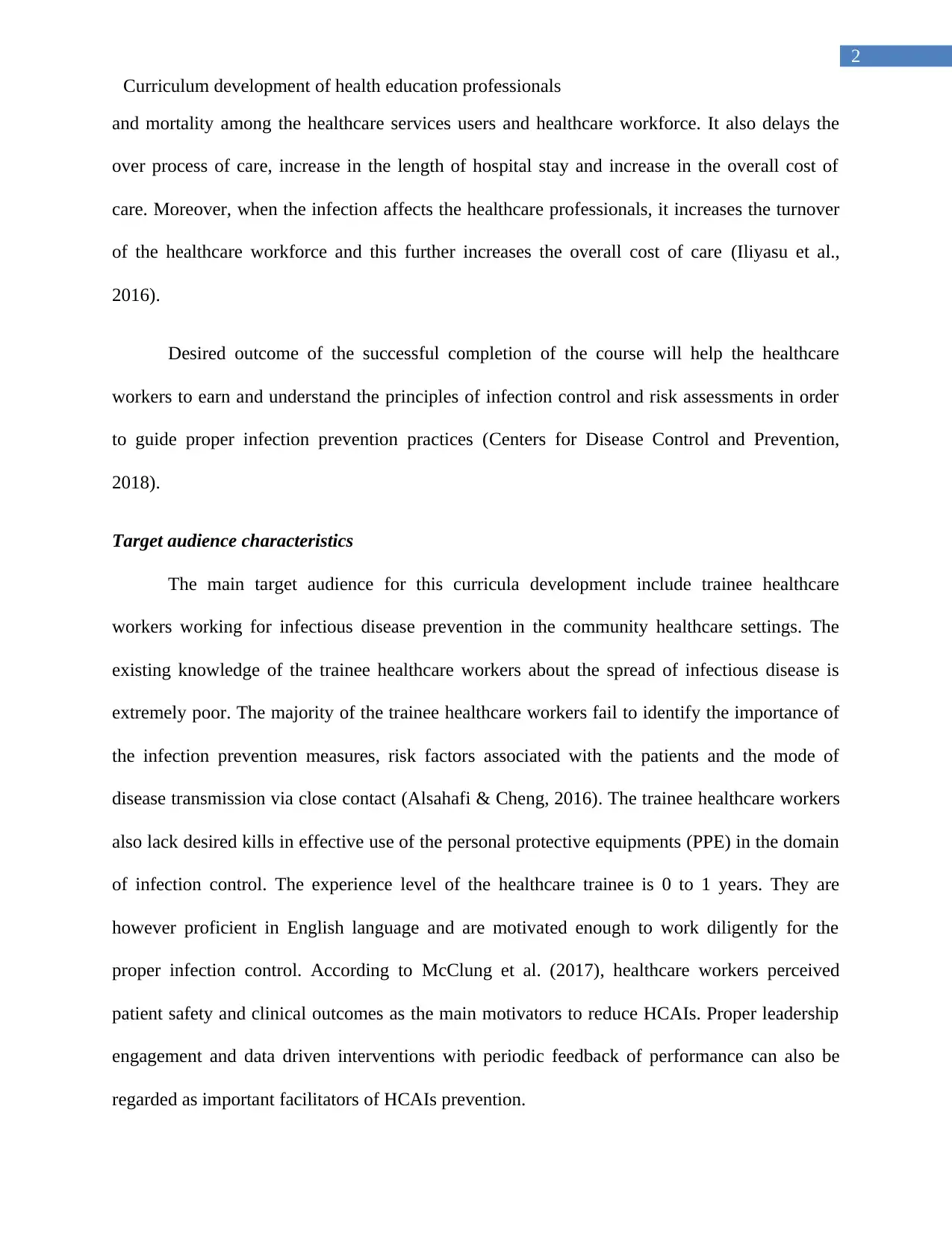
2
Curriculum development of health education professionals
and mortality among the healthcare services users and healthcare workforce. It also delays the
over process of care, increase in the length of hospital stay and increase in the overall cost of
care. Moreover, when the infection affects the healthcare professionals, it increases the turnover
of the healthcare workforce and this further increases the overall cost of care (Iliyasu et al.,
2016).
Desired outcome of the successful completion of the course will help the healthcare
workers to earn and understand the principles of infection control and risk assessments in order
to guide proper infection prevention practices (Centers for Disease Control and Prevention,
2018).
Target audience characteristics
The main target audience for this curricula development include trainee healthcare
workers working for infectious disease prevention in the community healthcare settings. The
existing knowledge of the trainee healthcare workers about the spread of infectious disease is
extremely poor. The majority of the trainee healthcare workers fail to identify the importance of
the infection prevention measures, risk factors associated with the patients and the mode of
disease transmission via close contact (Alsahafi & Cheng, 2016). The trainee healthcare workers
also lack desired kills in effective use of the personal protective equipments (PPE) in the domain
of infection control. The experience level of the healthcare trainee is 0 to 1 years. They are
however proficient in English language and are motivated enough to work diligently for the
proper infection control. According to McClung et al. (2017), healthcare workers perceived
patient safety and clinical outcomes as the main motivators to reduce HCAIs. Proper leadership
engagement and data driven interventions with periodic feedback of performance can also be
regarded as important facilitators of HCAIs prevention.
Curriculum development of health education professionals
and mortality among the healthcare services users and healthcare workforce. It also delays the
over process of care, increase in the length of hospital stay and increase in the overall cost of
care. Moreover, when the infection affects the healthcare professionals, it increases the turnover
of the healthcare workforce and this further increases the overall cost of care (Iliyasu et al.,
2016).
Desired outcome of the successful completion of the course will help the healthcare
workers to earn and understand the principles of infection control and risk assessments in order
to guide proper infection prevention practices (Centers for Disease Control and Prevention,
2018).
Target audience characteristics
The main target audience for this curricula development include trainee healthcare
workers working for infectious disease prevention in the community healthcare settings. The
existing knowledge of the trainee healthcare workers about the spread of infectious disease is
extremely poor. The majority of the trainee healthcare workers fail to identify the importance of
the infection prevention measures, risk factors associated with the patients and the mode of
disease transmission via close contact (Alsahafi & Cheng, 2016). The trainee healthcare workers
also lack desired kills in effective use of the personal protective equipments (PPE) in the domain
of infection control. The experience level of the healthcare trainee is 0 to 1 years. They are
however proficient in English language and are motivated enough to work diligently for the
proper infection control. According to McClung et al. (2017), healthcare workers perceived
patient safety and clinical outcomes as the main motivators to reduce HCAIs. Proper leadership
engagement and data driven interventions with periodic feedback of performance can also be
regarded as important facilitators of HCAIs prevention.
⊘ This is a preview!⊘
Do you want full access?
Subscribe today to unlock all pages.

Trusted by 1+ million students worldwide
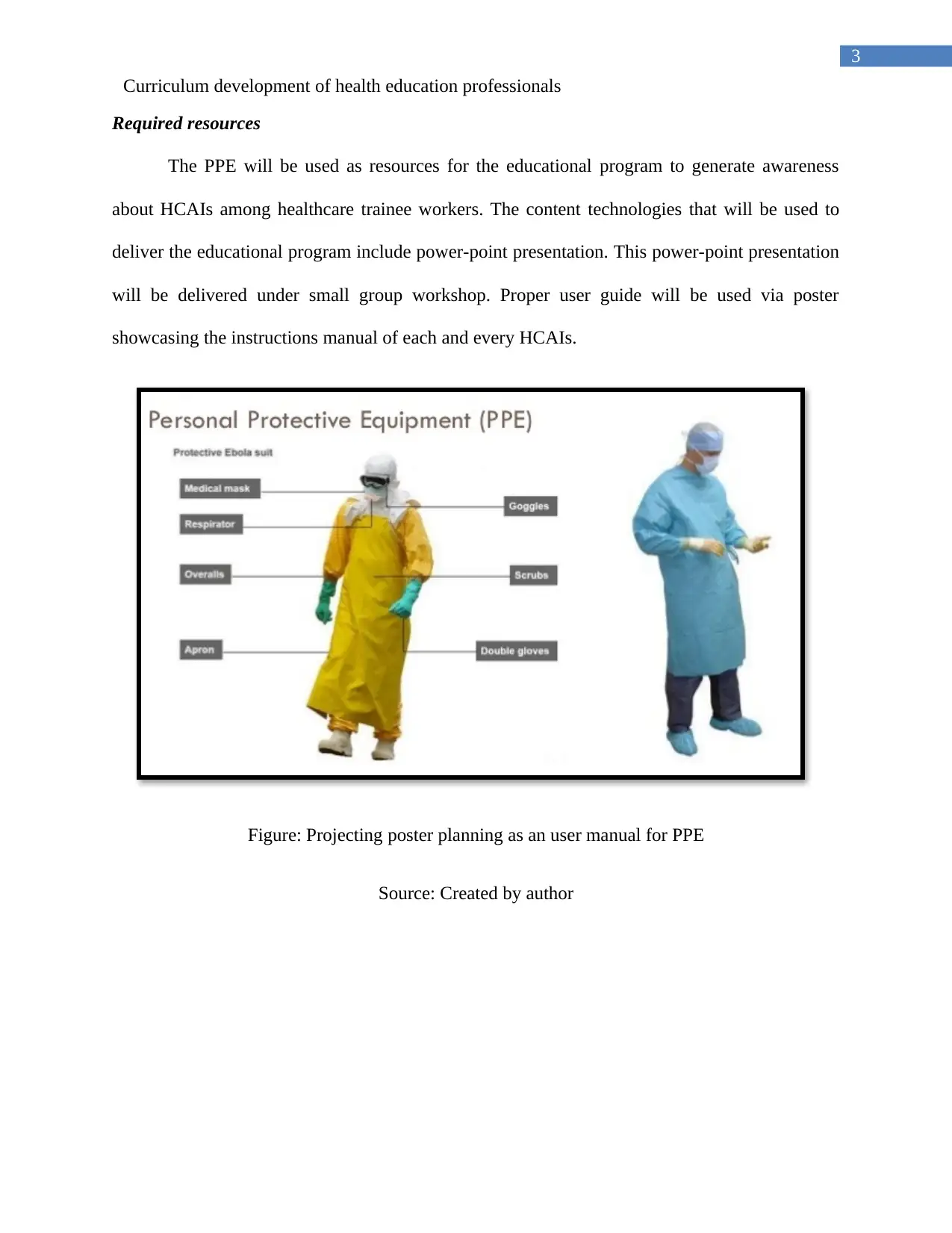
3
Curriculum development of health education professionals
Required resources
The PPE will be used as resources for the educational program to generate awareness
about HCAIs among healthcare trainee workers. The content technologies that will be used to
deliver the educational program include power-point presentation. This power-point presentation
will be delivered under small group workshop. Proper user guide will be used via poster
showcasing the instructions manual of each and every HCAIs.
Figure: Projecting poster planning as an user manual for PPE
Source: Created by author
Curriculum development of health education professionals
Required resources
The PPE will be used as resources for the educational program to generate awareness
about HCAIs among healthcare trainee workers. The content technologies that will be used to
deliver the educational program include power-point presentation. This power-point presentation
will be delivered under small group workshop. Proper user guide will be used via poster
showcasing the instructions manual of each and every HCAIs.
Figure: Projecting poster planning as an user manual for PPE
Source: Created by author
Paraphrase This Document
Need a fresh take? Get an instant paraphrase of this document with our AI Paraphraser
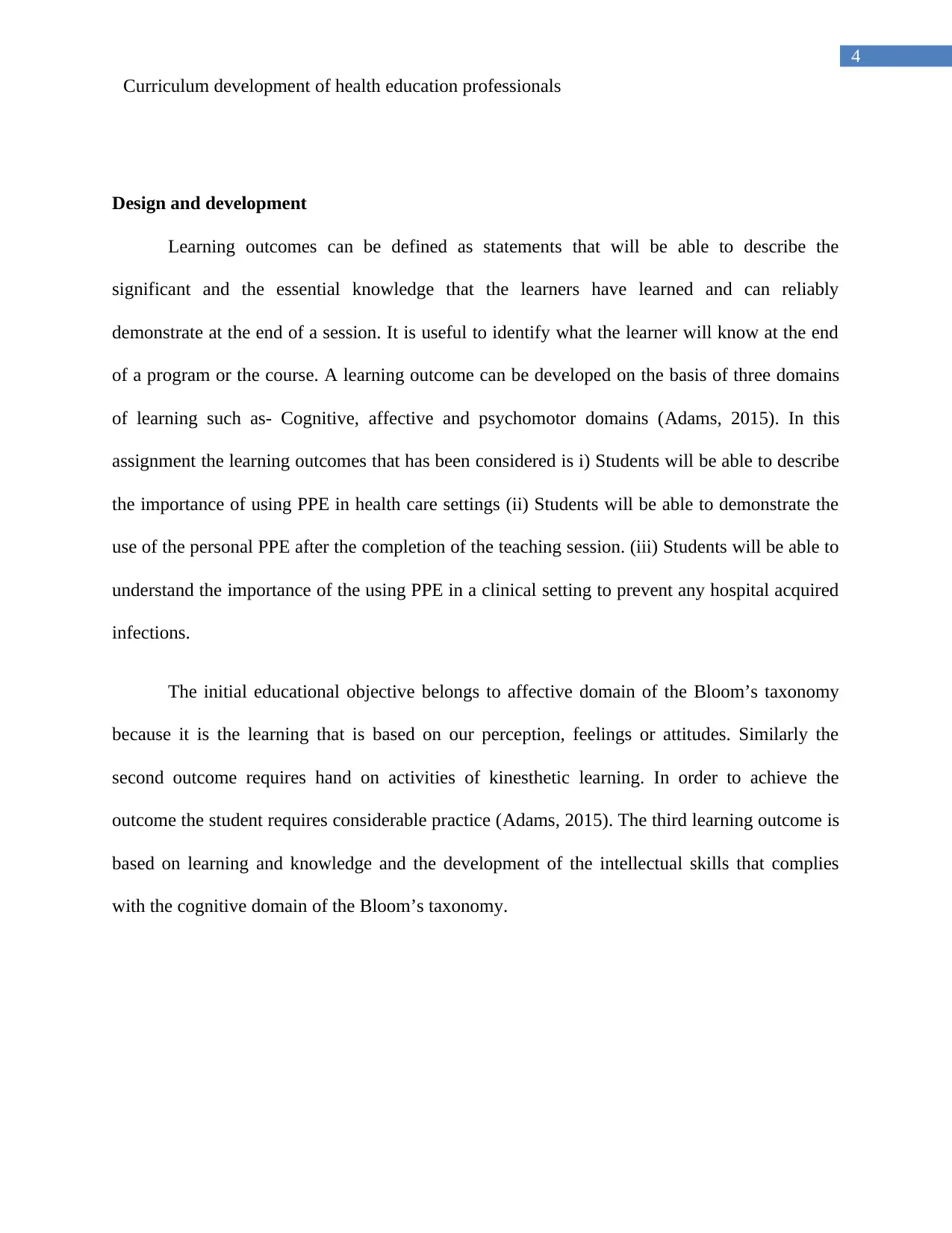
4
Curriculum development of health education professionals
Design and development
Learning outcomes can be defined as statements that will be able to describe the
significant and the essential knowledge that the learners have learned and can reliably
demonstrate at the end of a session. It is useful to identify what the learner will know at the end
of a program or the course. A learning outcome can be developed on the basis of three domains
of learning such as- Cognitive, affective and psychomotor domains (Adams, 2015). In this
assignment the learning outcomes that has been considered is i) Students will be able to describe
the importance of using PPE in health care settings (ii) Students will be able to demonstrate the
use of the personal PPE after the completion of the teaching session. (iii) Students will be able to
understand the importance of the using PPE in a clinical setting to prevent any hospital acquired
infections.
The initial educational objective belongs to affective domain of the Bloom’s taxonomy
because it is the learning that is based on our perception, feelings or attitudes. Similarly the
second outcome requires hand on activities of kinesthetic learning. In order to achieve the
outcome the student requires considerable practice (Adams, 2015). The third learning outcome is
based on learning and knowledge and the development of the intellectual skills that complies
with the cognitive domain of the Bloom’s taxonomy.
Curriculum development of health education professionals
Design and development
Learning outcomes can be defined as statements that will be able to describe the
significant and the essential knowledge that the learners have learned and can reliably
demonstrate at the end of a session. It is useful to identify what the learner will know at the end
of a program or the course. A learning outcome can be developed on the basis of three domains
of learning such as- Cognitive, affective and psychomotor domains (Adams, 2015). In this
assignment the learning outcomes that has been considered is i) Students will be able to describe
the importance of using PPE in health care settings (ii) Students will be able to demonstrate the
use of the personal PPE after the completion of the teaching session. (iii) Students will be able to
understand the importance of the using PPE in a clinical setting to prevent any hospital acquired
infections.
The initial educational objective belongs to affective domain of the Bloom’s taxonomy
because it is the learning that is based on our perception, feelings or attitudes. Similarly the
second outcome requires hand on activities of kinesthetic learning. In order to achieve the
outcome the student requires considerable practice (Adams, 2015). The third learning outcome is
based on learning and knowledge and the development of the intellectual skills that complies
with the cognitive domain of the Bloom’s taxonomy.
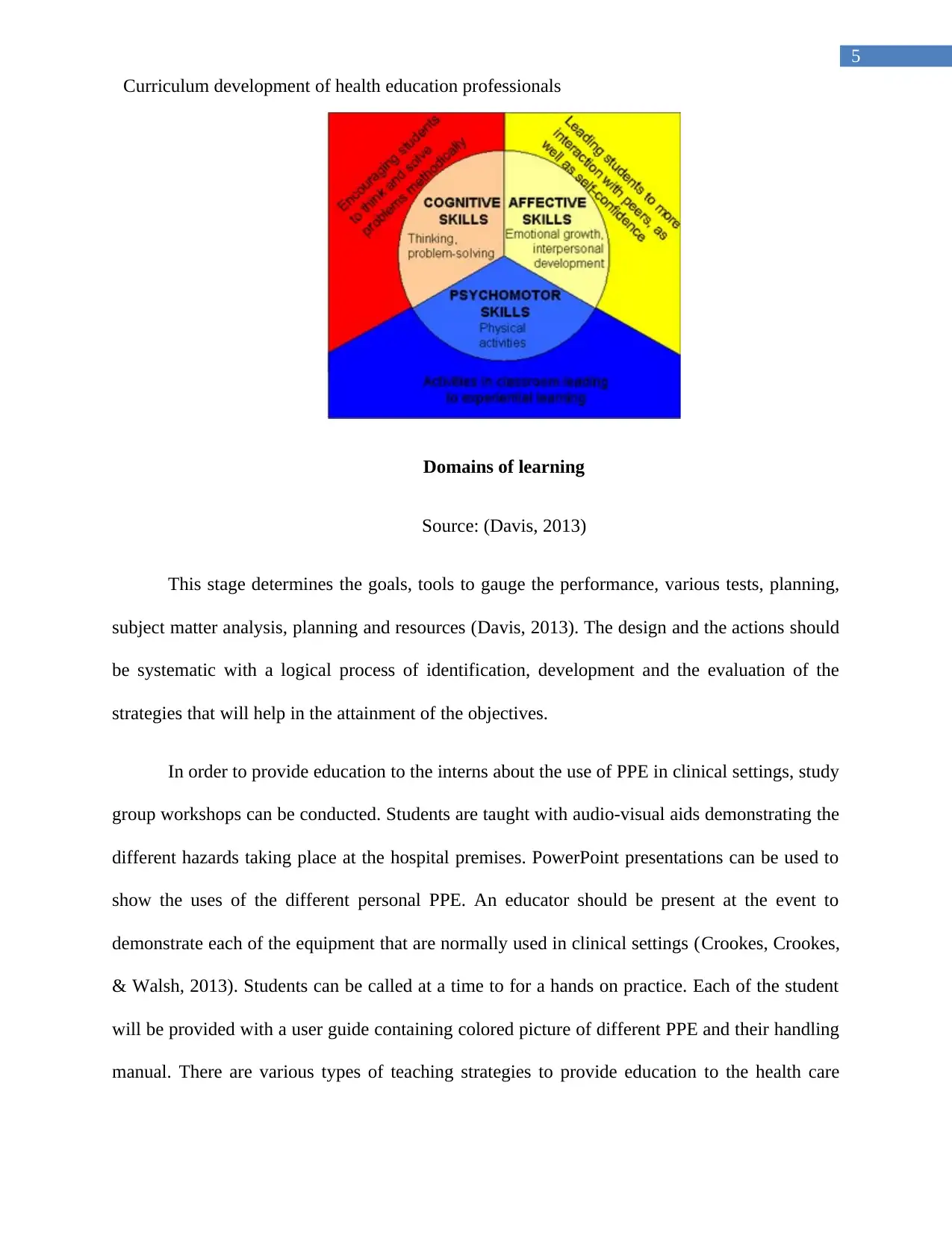
5
Curriculum development of health education professionals
Domains of learning
Source: (Davis, 2013)
This stage determines the goals, tools to gauge the performance, various tests, planning,
subject matter analysis, planning and resources (Davis, 2013). The design and the actions should
be systematic with a logical process of identification, development and the evaluation of the
strategies that will help in the attainment of the objectives.
In order to provide education to the interns about the use of PPE in clinical settings, study
group workshops can be conducted. Students are taught with audio-visual aids demonstrating the
different hazards taking place at the hospital premises. PowerPoint presentations can be used to
show the uses of the different personal PPE. An educator should be present at the event to
demonstrate each of the equipment that are normally used in clinical settings (Crookes, Crookes,
& Walsh, 2013). Students can be called at a time to for a hands on practice. Each of the student
will be provided with a user guide containing colored picture of different PPE and their handling
manual. There are various types of teaching strategies to provide education to the health care
Curriculum development of health education professionals
Domains of learning
Source: (Davis, 2013)
This stage determines the goals, tools to gauge the performance, various tests, planning,
subject matter analysis, planning and resources (Davis, 2013). The design and the actions should
be systematic with a logical process of identification, development and the evaluation of the
strategies that will help in the attainment of the objectives.
In order to provide education to the interns about the use of PPE in clinical settings, study
group workshops can be conducted. Students are taught with audio-visual aids demonstrating the
different hazards taking place at the hospital premises. PowerPoint presentations can be used to
show the uses of the different personal PPE. An educator should be present at the event to
demonstrate each of the equipment that are normally used in clinical settings (Crookes, Crookes,
& Walsh, 2013). Students can be called at a time to for a hands on practice. Each of the student
will be provided with a user guide containing colored picture of different PPE and their handling
manual. There are various types of teaching strategies to provide education to the health care
⊘ This is a preview!⊘
Do you want full access?
Subscribe today to unlock all pages.

Trusted by 1+ million students worldwide
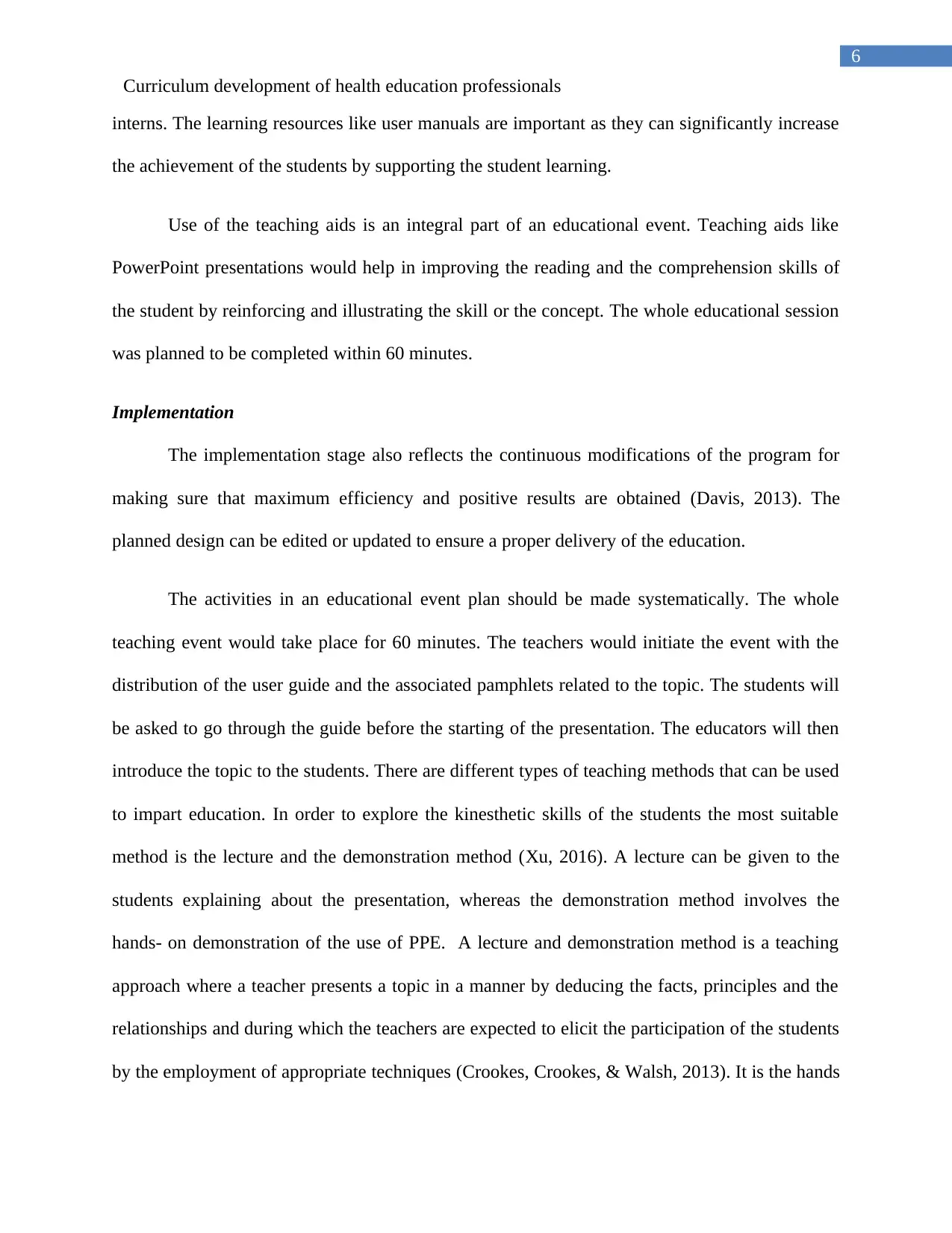
6
Curriculum development of health education professionals
interns. The learning resources like user manuals are important as they can significantly increase
the achievement of the students by supporting the student learning.
Use of the teaching aids is an integral part of an educational event. Teaching aids like
PowerPoint presentations would help in improving the reading and the comprehension skills of
the student by reinforcing and illustrating the skill or the concept. The whole educational session
was planned to be completed within 60 minutes.
Implementation
The implementation stage also reflects the continuous modifications of the program for
making sure that maximum efficiency and positive results are obtained (Davis, 2013). The
planned design can be edited or updated to ensure a proper delivery of the education.
The activities in an educational event plan should be made systematically. The whole
teaching event would take place for 60 minutes. The teachers would initiate the event with the
distribution of the user guide and the associated pamphlets related to the topic. The students will
be asked to go through the guide before the starting of the presentation. The educators will then
introduce the topic to the students. There are different types of teaching methods that can be used
to impart education. In order to explore the kinesthetic skills of the students the most suitable
method is the lecture and the demonstration method (Xu, 2016). A lecture can be given to the
students explaining about the presentation, whereas the demonstration method involves the
hands- on demonstration of the use of PPE. A lecture and demonstration method is a teaching
approach where a teacher presents a topic in a manner by deducing the facts, principles and the
relationships and during which the teachers are expected to elicit the participation of the students
by the employment of appropriate techniques (Crookes, Crookes, & Walsh, 2013). It is the hands
Curriculum development of health education professionals
interns. The learning resources like user manuals are important as they can significantly increase
the achievement of the students by supporting the student learning.
Use of the teaching aids is an integral part of an educational event. Teaching aids like
PowerPoint presentations would help in improving the reading and the comprehension skills of
the student by reinforcing and illustrating the skill or the concept. The whole educational session
was planned to be completed within 60 minutes.
Implementation
The implementation stage also reflects the continuous modifications of the program for
making sure that maximum efficiency and positive results are obtained (Davis, 2013). The
planned design can be edited or updated to ensure a proper delivery of the education.
The activities in an educational event plan should be made systematically. The whole
teaching event would take place for 60 minutes. The teachers would initiate the event with the
distribution of the user guide and the associated pamphlets related to the topic. The students will
be asked to go through the guide before the starting of the presentation. The educators will then
introduce the topic to the students. There are different types of teaching methods that can be used
to impart education. In order to explore the kinesthetic skills of the students the most suitable
method is the lecture and the demonstration method (Xu, 2016). A lecture can be given to the
students explaining about the presentation, whereas the demonstration method involves the
hands- on demonstration of the use of PPE. A lecture and demonstration method is a teaching
approach where a teacher presents a topic in a manner by deducing the facts, principles and the
relationships and during which the teachers are expected to elicit the participation of the students
by the employment of appropriate techniques (Crookes, Crookes, & Walsh, 2013). It is the hands
Paraphrase This Document
Need a fresh take? Get an instant paraphrase of this document with our AI Paraphraser
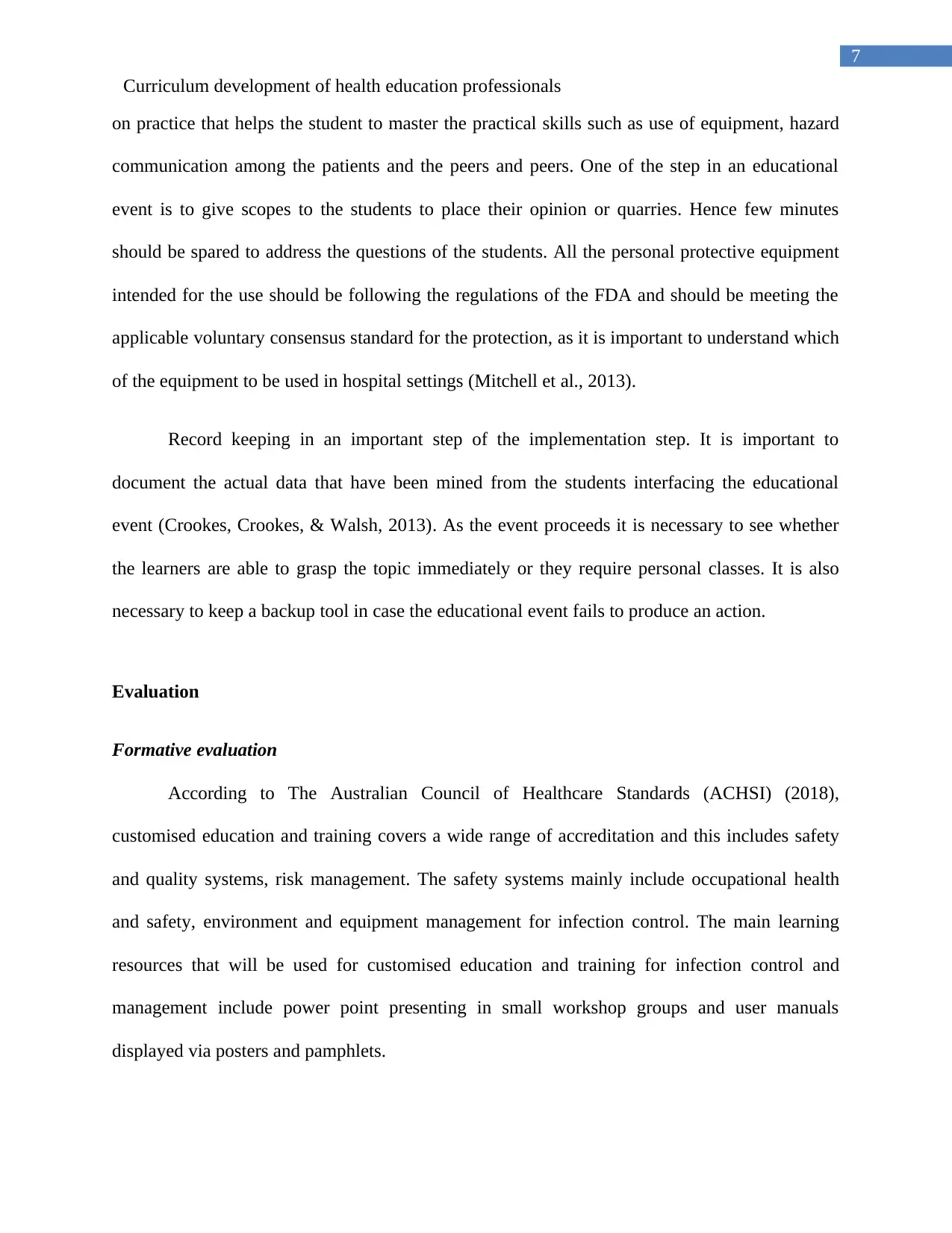
7
Curriculum development of health education professionals
on practice that helps the student to master the practical skills such as use of equipment, hazard
communication among the patients and the peers and peers. One of the step in an educational
event is to give scopes to the students to place their opinion or quarries. Hence few minutes
should be spared to address the questions of the students. All the personal protective equipment
intended for the use should be following the regulations of the FDA and should be meeting the
applicable voluntary consensus standard for the protection, as it is important to understand which
of the equipment to be used in hospital settings (Mitchell et al., 2013).
Record keeping in an important step of the implementation step. It is important to
document the actual data that have been mined from the students interfacing the educational
event (Crookes, Crookes, & Walsh, 2013). As the event proceeds it is necessary to see whether
the learners are able to grasp the topic immediately or they require personal classes. It is also
necessary to keep a backup tool in case the educational event fails to produce an action.
Evaluation
Formative evaluation
According to The Australian Council of Healthcare Standards (ACHSI) (2018),
customised education and training covers a wide range of accreditation and this includes safety
and quality systems, risk management. The safety systems mainly include occupational health
and safety, environment and equipment management for infection control. The main learning
resources that will be used for customised education and training for infection control and
management include power point presenting in small workshop groups and user manuals
displayed via posters and pamphlets.
Curriculum development of health education professionals
on practice that helps the student to master the practical skills such as use of equipment, hazard
communication among the patients and the peers and peers. One of the step in an educational
event is to give scopes to the students to place their opinion or quarries. Hence few minutes
should be spared to address the questions of the students. All the personal protective equipment
intended for the use should be following the regulations of the FDA and should be meeting the
applicable voluntary consensus standard for the protection, as it is important to understand which
of the equipment to be used in hospital settings (Mitchell et al., 2013).
Record keeping in an important step of the implementation step. It is important to
document the actual data that have been mined from the students interfacing the educational
event (Crookes, Crookes, & Walsh, 2013). As the event proceeds it is necessary to see whether
the learners are able to grasp the topic immediately or they require personal classes. It is also
necessary to keep a backup tool in case the educational event fails to produce an action.
Evaluation
Formative evaluation
According to The Australian Council of Healthcare Standards (ACHSI) (2018),
customised education and training covers a wide range of accreditation and this includes safety
and quality systems, risk management. The safety systems mainly include occupational health
and safety, environment and equipment management for infection control. The main learning
resources that will be used for customised education and training for infection control and
management include power point presenting in small workshop groups and user manuals
displayed via posters and pamphlets.
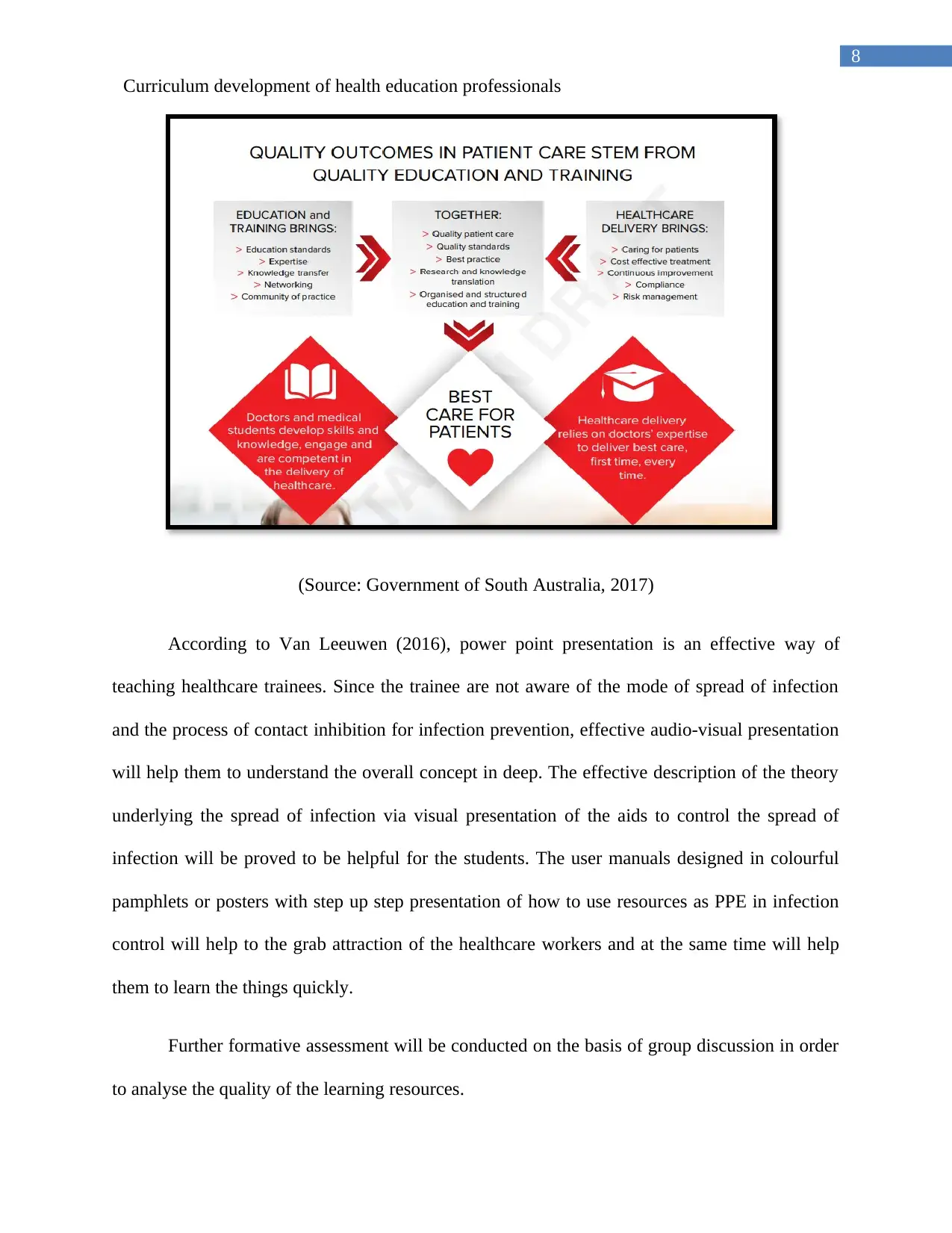
8
Curriculum development of health education professionals
(Source: Government of South Australia, 2017)
According to Van Leeuwen (2016), power point presentation is an effective way of
teaching healthcare trainees. Since the trainee are not aware of the mode of spread of infection
and the process of contact inhibition for infection prevention, effective audio-visual presentation
will help them to understand the overall concept in deep. The effective description of the theory
underlying the spread of infection via visual presentation of the aids to control the spread of
infection will be proved to be helpful for the students. The user manuals designed in colourful
pamphlets or posters with step up step presentation of how to use resources as PPE in infection
control will help to the grab attraction of the healthcare workers and at the same time will help
them to learn the things quickly.
Further formative assessment will be conducted on the basis of group discussion in order
to analyse the quality of the learning resources.
Curriculum development of health education professionals
(Source: Government of South Australia, 2017)
According to Van Leeuwen (2016), power point presentation is an effective way of
teaching healthcare trainees. Since the trainee are not aware of the mode of spread of infection
and the process of contact inhibition for infection prevention, effective audio-visual presentation
will help them to understand the overall concept in deep. The effective description of the theory
underlying the spread of infection via visual presentation of the aids to control the spread of
infection will be proved to be helpful for the students. The user manuals designed in colourful
pamphlets or posters with step up step presentation of how to use resources as PPE in infection
control will help to the grab attraction of the healthcare workers and at the same time will help
them to learn the things quickly.
Further formative assessment will be conducted on the basis of group discussion in order
to analyse the quality of the learning resources.
⊘ This is a preview!⊘
Do you want full access?
Subscribe today to unlock all pages.

Trusted by 1+ million students worldwide
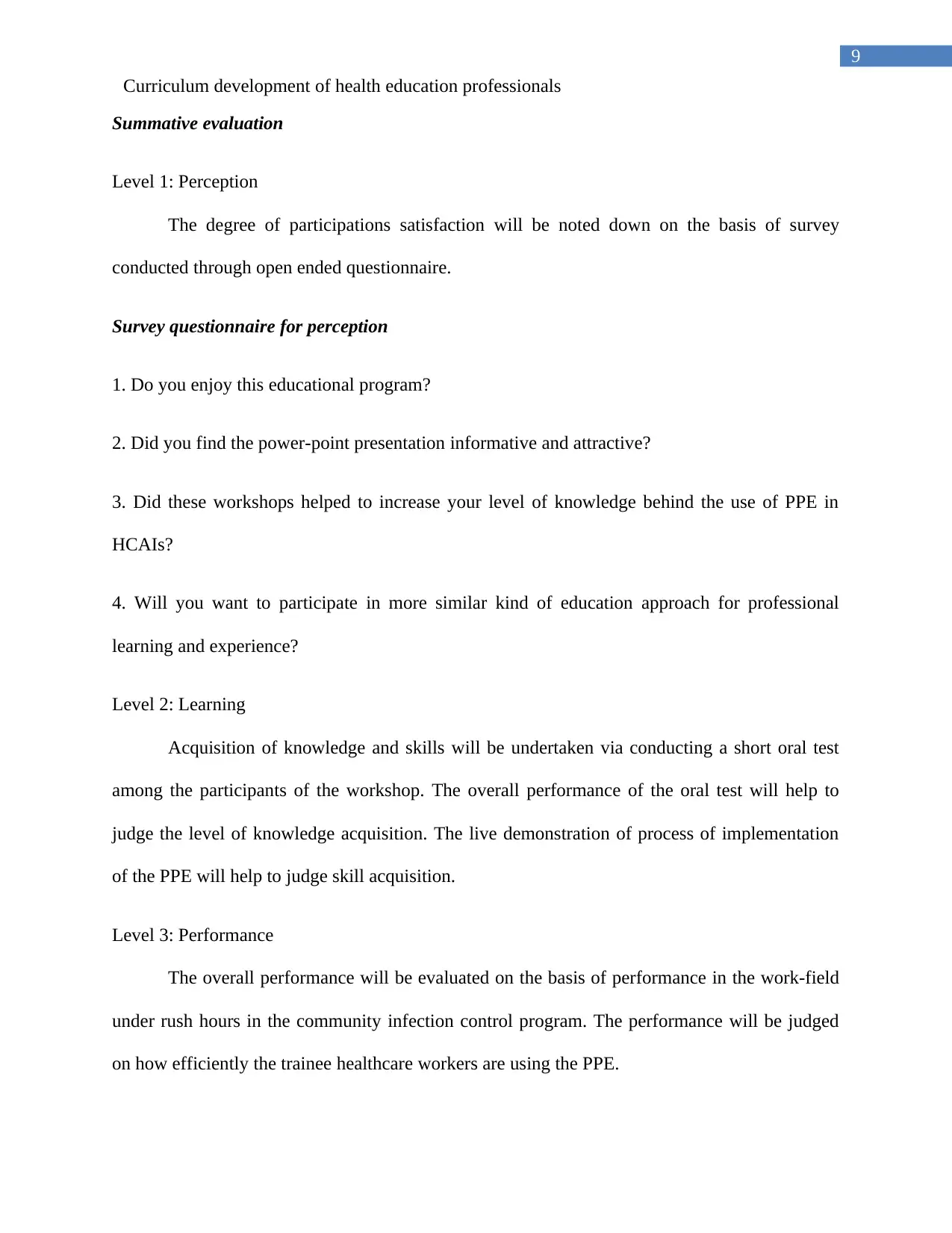
9
Curriculum development of health education professionals
Summative evaluation
Level 1: Perception
The degree of participations satisfaction will be noted down on the basis of survey
conducted through open ended questionnaire.
Survey questionnaire for perception
1. Do you enjoy this educational program?
2. Did you find the power-point presentation informative and attractive?
3. Did these workshops helped to increase your level of knowledge behind the use of PPE in
HCAIs?
4. Will you want to participate in more similar kind of education approach for professional
learning and experience?
Level 2: Learning
Acquisition of knowledge and skills will be undertaken via conducting a short oral test
among the participants of the workshop. The overall performance of the oral test will help to
judge the level of knowledge acquisition. The live demonstration of process of implementation
of the PPE will help to judge skill acquisition.
Level 3: Performance
The overall performance will be evaluated on the basis of performance in the work-field
under rush hours in the community infection control program. The performance will be judged
on how efficiently the trainee healthcare workers are using the PPE.
Curriculum development of health education professionals
Summative evaluation
Level 1: Perception
The degree of participations satisfaction will be noted down on the basis of survey
conducted through open ended questionnaire.
Survey questionnaire for perception
1. Do you enjoy this educational program?
2. Did you find the power-point presentation informative and attractive?
3. Did these workshops helped to increase your level of knowledge behind the use of PPE in
HCAIs?
4. Will you want to participate in more similar kind of education approach for professional
learning and experience?
Level 2: Learning
Acquisition of knowledge and skills will be undertaken via conducting a short oral test
among the participants of the workshop. The overall performance of the oral test will help to
judge the level of knowledge acquisition. The live demonstration of process of implementation
of the PPE will help to judge skill acquisition.
Level 3: Performance
The overall performance will be evaluated on the basis of performance in the work-field
under rush hours in the community infection control program. The performance will be judged
on how efficiently the trainee healthcare workers are using the PPE.
Paraphrase This Document
Need a fresh take? Get an instant paraphrase of this document with our AI Paraphraser
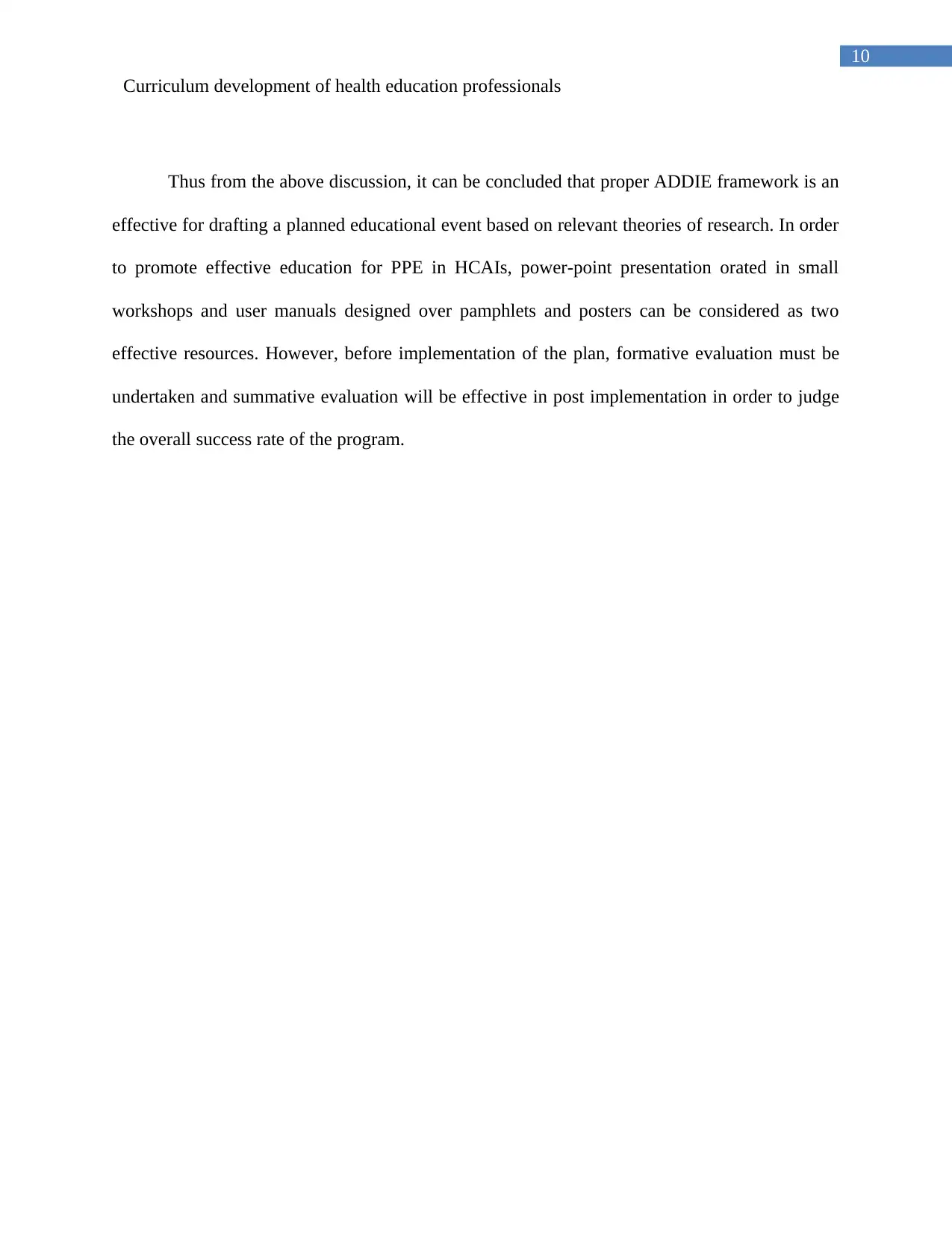
10
Curriculum development of health education professionals
Thus from the above discussion, it can be concluded that proper ADDIE framework is an
effective for drafting a planned educational event based on relevant theories of research. In order
to promote effective education for PPE in HCAIs, power-point presentation orated in small
workshops and user manuals designed over pamphlets and posters can be considered as two
effective resources. However, before implementation of the plan, formative evaluation must be
undertaken and summative evaluation will be effective in post implementation in order to judge
the overall success rate of the program.
Curriculum development of health education professionals
Thus from the above discussion, it can be concluded that proper ADDIE framework is an
effective for drafting a planned educational event based on relevant theories of research. In order
to promote effective education for PPE in HCAIs, power-point presentation orated in small
workshops and user manuals designed over pamphlets and posters can be considered as two
effective resources. However, before implementation of the plan, formative evaluation must be
undertaken and summative evaluation will be effective in post implementation in order to judge
the overall success rate of the program.
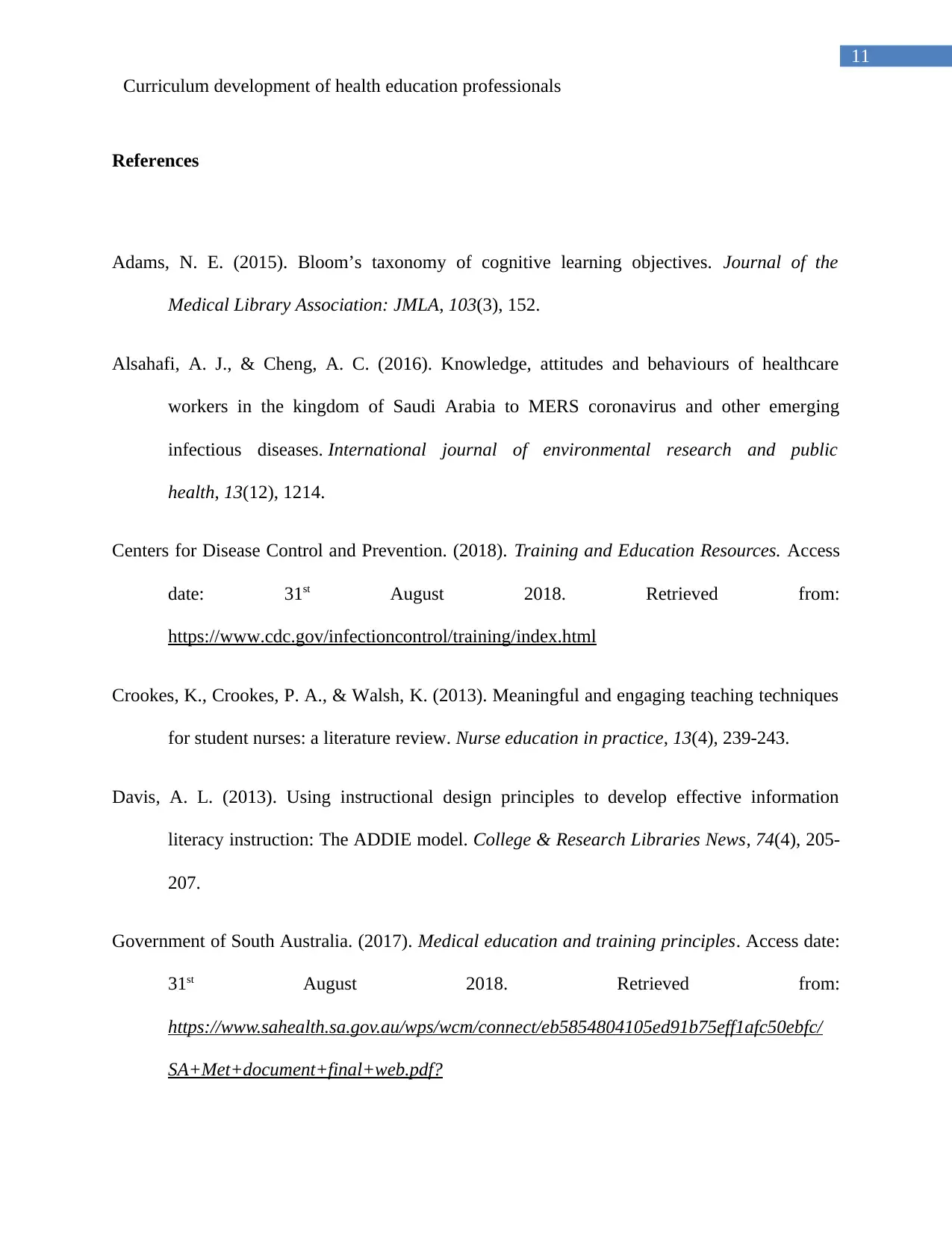
11
Curriculum development of health education professionals
References
Adams, N. E. (2015). Bloom’s taxonomy of cognitive learning objectives. Journal of the
Medical Library Association: JMLA, 103(3), 152.
Alsahafi, A. J., & Cheng, A. C. (2016). Knowledge, attitudes and behaviours of healthcare
workers in the kingdom of Saudi Arabia to MERS coronavirus and other emerging
infectious diseases. International journal of environmental research and public
health, 13(12), 1214.
Centers for Disease Control and Prevention. (2018). Training and Education Resources. Access
date: 31st August 2018. Retrieved from:
https://www.cdc.gov/infectioncontrol/training/index.html
Crookes, K., Crookes, P. A., & Walsh, K. (2013). Meaningful and engaging teaching techniques
for student nurses: a literature review. Nurse education in practice, 13(4), 239-243.
Davis, A. L. (2013). Using instructional design principles to develop effective information
literacy instruction: The ADDIE model. College & Research Libraries News, 74(4), 205-
207.
Government of South Australia. (2017). Medical education and training principles. Access date:
31st August 2018. Retrieved from:
https://www.sahealth.sa.gov.au/wps/wcm/connect/eb5854804105ed91b75eff1afc50ebfc/
SA+Met+document+final+web.pdf?
Curriculum development of health education professionals
References
Adams, N. E. (2015). Bloom’s taxonomy of cognitive learning objectives. Journal of the
Medical Library Association: JMLA, 103(3), 152.
Alsahafi, A. J., & Cheng, A. C. (2016). Knowledge, attitudes and behaviours of healthcare
workers in the kingdom of Saudi Arabia to MERS coronavirus and other emerging
infectious diseases. International journal of environmental research and public
health, 13(12), 1214.
Centers for Disease Control and Prevention. (2018). Training and Education Resources. Access
date: 31st August 2018. Retrieved from:
https://www.cdc.gov/infectioncontrol/training/index.html
Crookes, K., Crookes, P. A., & Walsh, K. (2013). Meaningful and engaging teaching techniques
for student nurses: a literature review. Nurse education in practice, 13(4), 239-243.
Davis, A. L. (2013). Using instructional design principles to develop effective information
literacy instruction: The ADDIE model. College & Research Libraries News, 74(4), 205-
207.
Government of South Australia. (2017). Medical education and training principles. Access date:
31st August 2018. Retrieved from:
https://www.sahealth.sa.gov.au/wps/wcm/connect/eb5854804105ed91b75eff1afc50ebfc/
SA+Met+document+final+web.pdf?
⊘ This is a preview!⊘
Do you want full access?
Subscribe today to unlock all pages.

Trusted by 1+ million students worldwide
1 out of 14
Related Documents
Your All-in-One AI-Powered Toolkit for Academic Success.
+13062052269
info@desklib.com
Available 24*7 on WhatsApp / Email
![[object Object]](/_next/static/media/star-bottom.7253800d.svg)
Unlock your academic potential
Copyright © 2020–2025 A2Z Services. All Rights Reserved. Developed and managed by ZUCOL.





